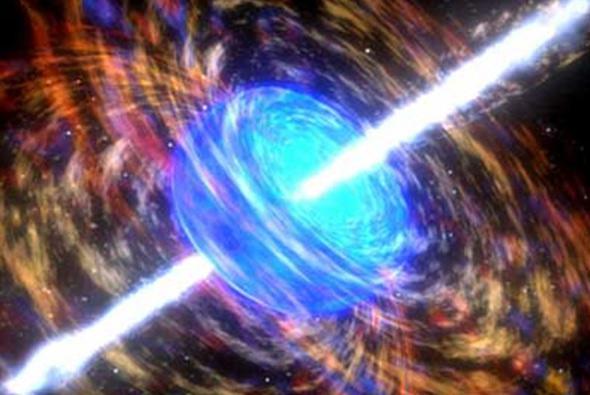Ten years ago today—on Nov. 20, 2004, at 17:16 UTC—a Delta II rocket thundered into the sky. Sitting inside the payload cowling was NASA’s Swift observatory, awaiting its chance to revolutionize astronomy.
Swift was sent into orbit to look for gamma-ray bursts, the most violent bangs in the Universe since The Big One. These explosions are the birth cries of black holes and occur somewhere in the Universe every day.
They’re so luminous they can be seen clear across the Universe, but so short in duration that in some cases, literally, if you blink you’ll miss them. They made them incredibly hard to study; it was a lucky break when a burst in 1997 was caught by an X-ray satellite called BeppoSax, the first to have its distance accurately determined; it was a whopping 6 billion light-years away! The history of GRBs involves the cold war, nuclear bomb testing, and many, many years of astronomers scratching their heads. It was one of the most enduring mysteries in astronomy,* and Swift helped us understand them better than any observatory before it.
Swift was designed and built to detect GRBs in gamma rays, X-rays, ultraviolet, and optical light—a huge chunk of the electromagnetic spectrum—and rapidly slew over to point at them, sometimes in well under a minute. It was named after the acrobatic bird, which catches huge numbers of insects on the fly.
It turned out to be a good name.

Artwork by Dana Berry/NASA/SkyWorks Digital
Swift quickly became the go-to observatory for GRB detection. By the end of 2004 it found nine GRBs—averaging about one per week—even before its observational methods had been fine-tuned. As I write this, after 10 years, it’s detected 921 of these cosmic explosions! That’s stunning.
As soon as it detects a burst, it sends the coordinates out via the Gamma-Ray Coordinates Network. Telescopes hooked up to the network can automatically look for the burst within moments of its discovery that way, and hope to catch the rapidly fading afterglow, caused by the initial explosion sending out so much energy and high speed matter that in a few seconds it dwarfs the Sun’s entire energy output over its entire 11 billion year lifetime!
GRBs are awe-inspiring.
Along the way Swift’s also seen a magnetar explosion (one of the very few astronomical events that actually freak me out due to their mind-crushing violence and scale), watched a neutron star get torn apart by a black hole (!!!), observed hundreds of galaxies, exploding stars, asteroids, comets, and more … including, get this, the single most luminous event ever witnessed by humans up to that time. And Swift is still up there, orbiting the Earth, scanning the skies diligently and patiently, waiting for the next burst. You can even see a map of the sky showing where the latest bursts have been seen.
Although I wasn’t involved with the science of the mission except tangentially, I worked for many years on the education and public outreach part of the mission. I wrote countless articles about Swift, including much of the EPO website. Our team at Sonoma State University designed a lot of activities for kids using Swift science, including brochures, a paper model of the satellite, classroom activities, a planetarium show, and a lot more. I’m still pretty proud of the work we did for Swift.
And I’m proud of the satellite. It was relatively inexpensive (the total mission cost was about $250 million), and it’s performed nearly flawlessly in the ravages of space for a decade. It’s a paragon of international cooperation to study the Universe, and a true achievement for NASA.
Congratulations to the entire Swift team, and happy anniversary. You deserve it.
* I wrote about this for my book Death From the Skies!, and/or you can read more about it here.
